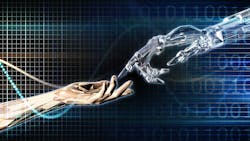Dental AI: Helping dentists diagnose sooner and patients accept treatment earlier
AI has been the topic d'jour since ChatGPT launched publicly in late 2022. While many exciting generative AI use cases have made headlines, when I think about the value of AI, I think about what’s happening in our industry. I think about the real-world value dental AI offers us and our patients.
The dental industry's charter
As a dental community, delivering excellent treatment is our number one priority. When patients come in for their routine screenings, they expect us to be on our game, catch all dental issues, and recommend appropriate treatment.
But the truth is, we’re human. We’re understaffed and overworked. We’re completing exams while also seeing restorative patients and emergencies. We’re running a business, worried about HR issues, or thinking about writing to an insurance payor about a rejected claim. There's a chance we may miss a symptom-free, tiny indication of an early-stage lesion on an x-ray. Unfortunately, if what's tiny today remains untreated, it could progress into a chronic clinical condition.
Until recently, dentists could make treatment decisions and recommendations based only on what they could physically observe. Because chronic oral issues can start before they're visible to the naked eye, we have been limited in our ability to see and treat the earliest signs of decay and disease. This is why dental AI is so exciting and such a boon for dentists and patients. It can help dentists detect oral health concerns earlier and more accurately.
You might also be interested in: Is AI-generated content the future of dental SEO?
The promise of dental AI in my offices
In my offices, 42 North Dental, we're testing, deploying, and offering best-in-class dental AI to dentists across our organization. Why? Because we're big believers in technology and helping our doctors provide the best care possible while also calibrating our providers so we can assure patients receive exceptional care. Knowing we have a way to ensure that all providers are diagnosing at the highest level allows me to sleep at night.
When we started reviewing dental AI at 42 North Dental, our dentists examined 100-plus images with the naked eye and then with VideaHealth's AI. When aided by AI, the dentists found nearly 20% more carious lesions. In an FDA study, 100% of dentists using VideaHealth's AI saw an improved ability to detect lesions, no matter their experience level. In this same study, dentists experienced an average increase of 31% in the detection of carious lesions. While results may vary, neither set of numbers are insignificant or without impact for dental practices and patients.
Dental AI can help identify more variation and indications of areas that require further examination. But AI is by no means a replacement for dentists. Instead, these data-driven recommendations augment the dentist's valuable clinical experience and insights, offering objective, consistent observations to consider when making their clinical decisions and recommendations. Dentists will remain a critical part of the equation in disease diagnostics as they have the context of experience, patient histories, in-person examinations, and more.
Building trust and improving outcomes
When a medical doctor tells a patient they have diabetes, high blood pressure, or a risk of cardiac issues, patients typically make an effort to comply with treatment recommendations. Why? Because those insights are based on data—A1C numbers, blood pressure, and cholesterol levels. Today's patients trust data and objectivity.
Dental AI is another tool for increasing transparency and insights, a clinical ally if you will. Every dentist using dental AI can provide their patients a highly sophisticated, on-demand, data-powered second opinion without bias. We’ve all heard the proverb "Don't judge a book by its cover." Well, it happens, and AI can eliminate the bias that often comes with evaluating a patient and their oral health.
The AI states the facts and eliminates the opportunity to miss a lesion on a film because we don't think the patient can have pathology since they look healthy. It forces providers to have factual, data-driven conversations with patients about their oral health.
In turn, the transparency and visibility dentists offer when leveraging dental AI improve patient outcomes. Specifically, this can drive up case acceptance or earlier adoption of treatment plans. Current patient acceptance ranges from reasonable to dismal; every clinician leveraging dental AI will have an opportunity to help patients understand the benefit of early intervention. The data supports it.
Consider the significance here. This is transformative for dentists, patients, and the health-care model itself. We’ve all seen patients without symptoms who delay treatment, and we may still see that, but now we have a transparent way to accelerate and pull forward that treatment.
We cannot afford to make mistakes or to miss disease or decay. Implementing AI allows us to not only prevent mistakes and avoid underdiagnosis but improve oral health faster with earlier caries detection and measurement of early bone loss. This will drive better overall health and reduce chronic diseases.
Dental AI: Augmenting dentists, not replacing them
The quiet objection being whispered might be, "Will dental AI replace dentists?"
The answer: Not for a moment.
Dental AI is a tool. We’ve never turned away from clinical tools that can make our jobs more effective, accurate, and meaningful. Why start now? It’s time to use the new tools that provide a better patient experience. Clinicians offer their patients so much more than x-ray analysis. We are our patients' collaborators, advisors, educators, and partners. AI is just helping us deliver the best care possible. Dental AI is where the future is.
Editor's note: This article originally appeared in DE Weekend, the newsletter that will elevate your Sunday mornings with practical and innovative practice management and clinical content from experts across the field. Subscribe here.
About the Author

Michael Scialabba, DDS
Michael Scialabba, DDS, is chief clinical officer at 42 North Dental and chairman of the Massachusetts Dental Board. Previous roles include Chief of Dental at Harvard Vanguard Medical Associates and CEO of Great Hill Dental Partners. Dr. Scialabba has a BS in finance from Boston College, a certificate with ADA in dental practice management from the University of Notre Dame – Mendoza College of Business, and his DDS from Stony Brook University.
